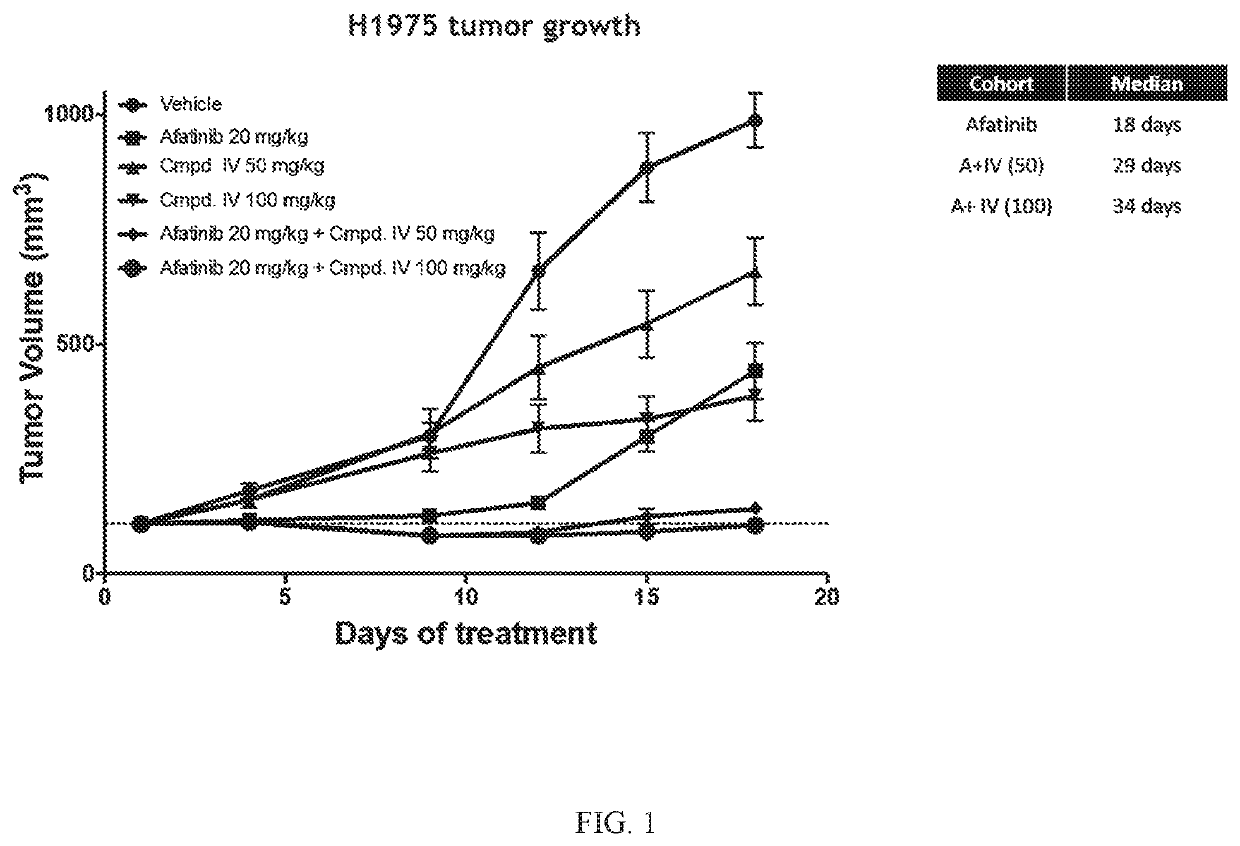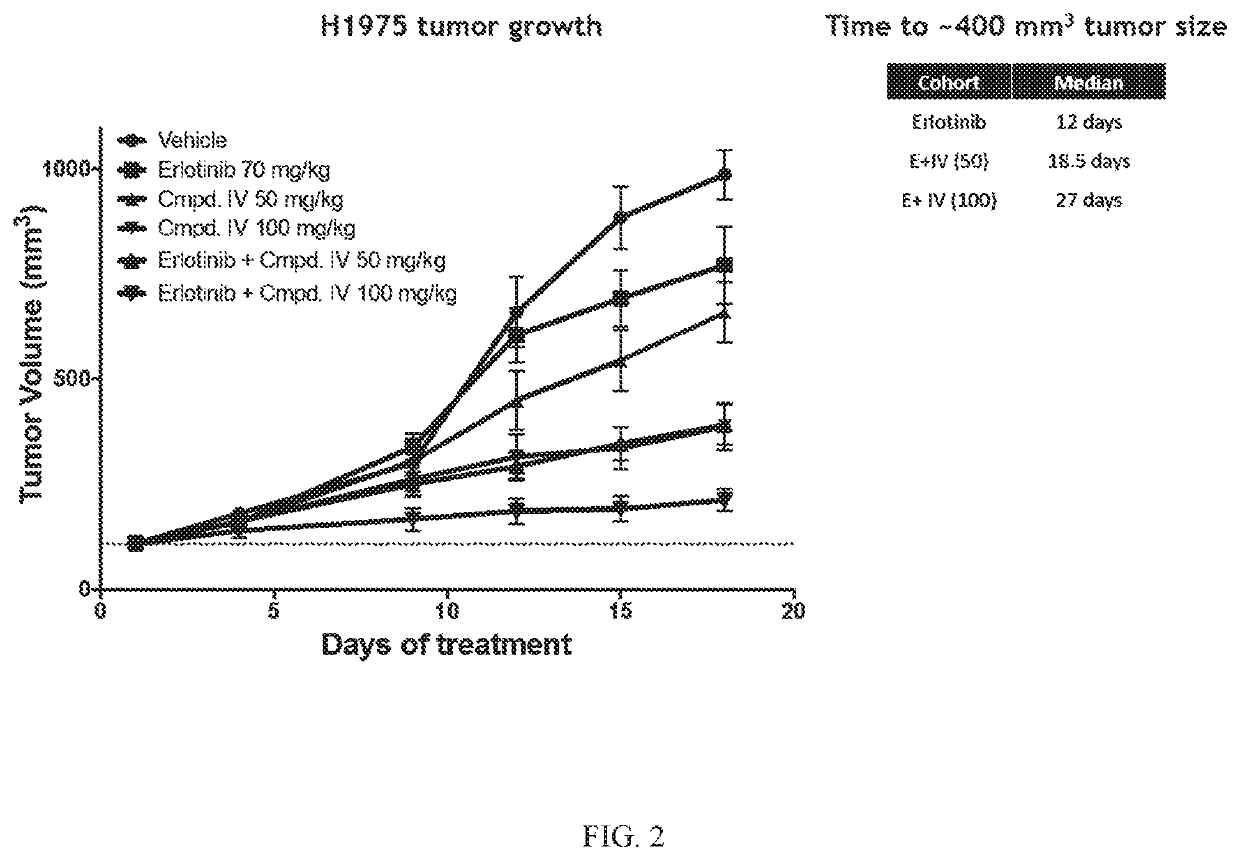Treatment of EGFR-driven cancer with fewer side effects
a cancer and egfr technology, applied in the direction of antineoplastic agents, medical preparations, drug compositions, etc., can solve the problems of difficult management and significant side effects
- Summary
- Abstract
- Description
- Claims
- Application Information
AI Technical Summary
Benefits of technology
Problems solved by technology
Method used
Image
Examples
example 1
The Effect of Compound IV in Combination with Afatinib in an EGFRL858R / T790M NSCLC Model.
[0236]Compound IV in combination with the EGFR-TKI afatinib was tested in an EGFRL858R / T790M NSCLC model. The combination of Compound IV in dosages of 50 mg / kg and 100 mg / kg+afatinib was tested and compared to treatment regimens consisting of only Compound IV (in 50 mg / kg dose or a 100 mg / kg) or afatinib (20 mg / kg). H1975 (EGFRL858R / T790M NSCLC Model) tumor bearing mice were treated daily. Tumors were measured twice a week until vehicle treated mice tumors reached about 1000 mm3 (18 days). Data is plotted to compare tumor growth in each cohort during the 18 days of treatment.
[0237]Compound IV when administered at either 50 mg / kg or 100 mg / kg in combination with afatinib increased the afatinib efficacy and extended the time to resistance in the EGFRL858R / T790M NSCLC model. The combination treatment was more effective at decreasing tumor volume than treatment that only consisted of both Compound I...
example 2
The Effect of Compound IV in Combination with Erlotinib in an EGFRL858R / T790M NSCLC Model.
[0238]Compound IV in combination with the EGFR-TKI erlotinib was tested in an EGFRL858R / T790M NSCLC model. The combination of Compound IV in dosages of 50 mg / kg and 100 mg / kg+erlotinib was tested and compared to treatment regimens consisting of only Compound IV (in 50 mg / kg dose or a 100 mg / kg) or erlotinib (70 mg / kg). H1975 (EGFRL858R / T790M NSCLC Model) tumor bearing mice were treated daily. Tumors were measured twice a week until vehicle treated mice tumors reached about 1000 mm3 (18 days). Data is plotted to compare tumor growth in each cohort during the 18 days of treatment.
[0239]Compound IV when administered at either 50 mg / kg or 100 mg / kg in combination with erlotinib reversed erlotinib resistance in the EGFRL858R / T790M NSCLC model. Results are shown in FIG. 2.
example 3
The Effect of Compound IV in Combination with Afatinib in an EGFRL858R / T790M NSCLC Model.
[0240]Compound IV in combination with the EGFR-TKI afatinib was tested in an EGFRL858R / T790M NSCLC model to determine the ability of the combination to reverse afatinib resistance. H1975 (EGFRL858R / T790M NSCLC Model) tumor bearing mice were treated daily with 20 mg / kg of afatinib. Once tumors became resistant to afatinib (about D18), Compound IV (100 mg / kg) was added to the treatment regimen. Tumors were measured twice a week for 40 days. Data is plotted to compare tumor growth in each cohort during treatment.
[0241]Compound IV when administered at either 50 mg / kg or 100 mg / kg in combination with afatinib increased the afatinib efficacy and extended the time to resistance in the EGFRL858R / T790M NSCLC model. The combination treatment was more effective at decreasing tumor volume than treatment that only consisted of both Compound IV alone and afatinib alone. Results are shown in FIG. 1.
PUM
| Property | Measurement | Unit |
|---|---|---|
| median time | aaaaa | aaaaa |
| median time | aaaaa | aaaaa |
| median time | aaaaa | aaaaa |
Abstract
Description
Claims
Application Information
 Login to View More
Login to View More - R&D
- Intellectual Property
- Life Sciences
- Materials
- Tech Scout
- Unparalleled Data Quality
- Higher Quality Content
- 60% Fewer Hallucinations
Browse by: Latest US Patents, China's latest patents, Technical Efficacy Thesaurus, Application Domain, Technology Topic, Popular Technical Reports.
© 2025 PatSnap. All rights reserved.Legal|Privacy policy|Modern Slavery Act Transparency Statement|Sitemap|About US| Contact US: help@patsnap.com



